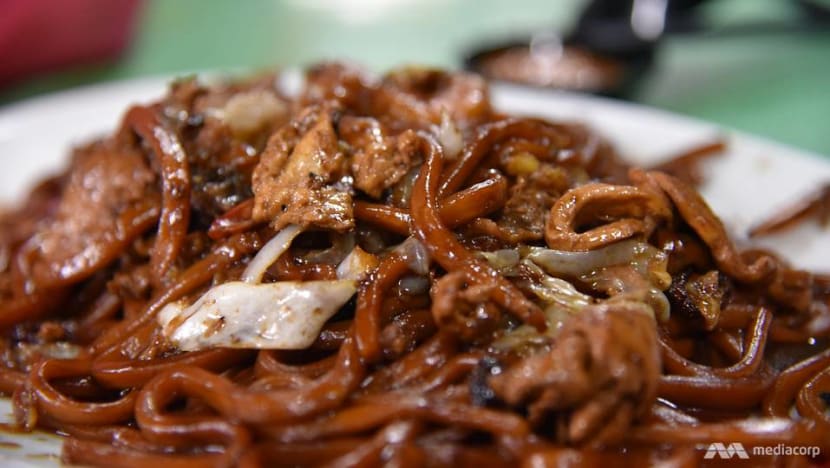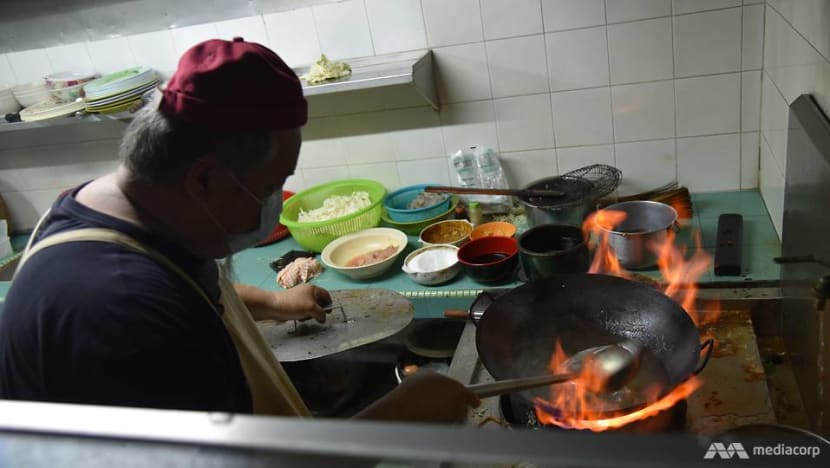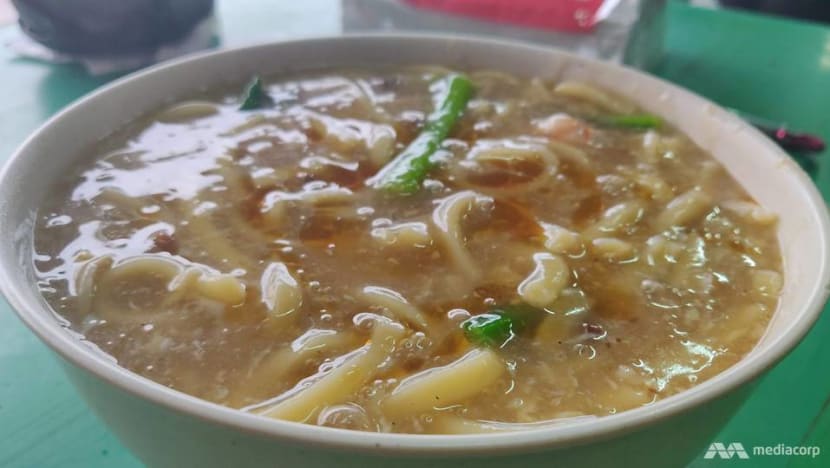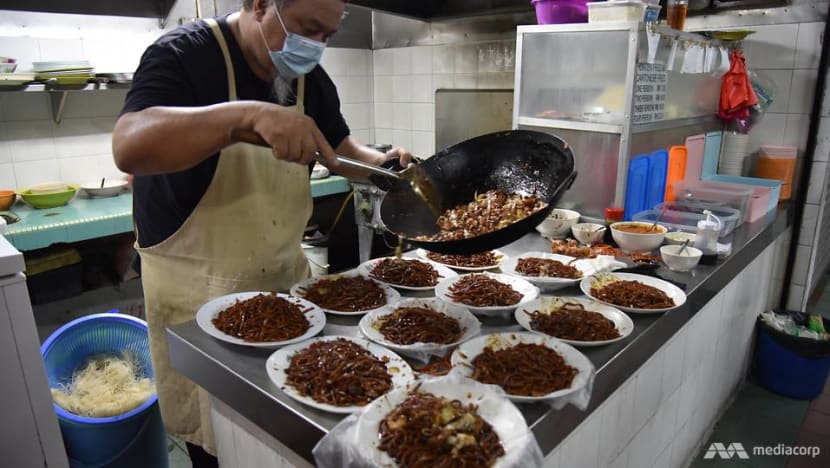Crispy chicken cracklings the star ingredient in this halal Hokkien mee in Petaling Jaya

With years of experience, producing a halal version of Hokkien mee is no problem for Jamal Tan, who has been cooking since he was 17. (Photo: Vincent Tan)
PETALING JAYA: Flames licked the wok as Jamal Tan Abdullah stirred the thick noodles furiously, his ladle knocking against the inside of the wok.
Next to him, an array of empty platters, some with plastic wrapping laid on top for takeaways, others without for dine-in customers, have been arranged on the metal countertop.
Once he was done cooking, he deftly ladled out the servings for each plate according to the dish sizes which indicated whether it was for a solo diner, two people or more.
The noodle dish glistened with thick dark sauce is the halal version of a well-known local hawker fare, Hokkien mee. Jamal, who operates the stall in a hawker centre in Old Town, Petaling Jaya, uses deep fried chicken cracklings in place of lard.

For a stall which runs between four-and-a-half and five hours, four days a week selling basic, yet hearty noodles, there is often a long line of waiting customers, both Muslim and otherwise.
Jamal would usually run out of the crowd favourites such as Hokkien mee and kway teow before closing, and he and his wife Ooi Hai Choo have to regretfully inform customers that they only had beehoon left.
READ: Singapore-style fried Hokkien prawn mee woos Malaysian foodies in Petaling Jaya
“I converted to Islam in 2008, and my wife in 2014. Before this, I used to cook non-halal,” said Jamal, whose original name was Tan Kian Giap.

Jamal is the third generation to run the Hokkien mee stall, after his grandfather set up a food stall in 1957. He started cooking when he was 17 years old.
“We used to cook and sell our noodles under the large trees, less than 50m from my current stall, where the food court’s toilets are,” he said.
In 1997, the local authority, then a municipal council, levelled the area and built the food court as a proper venue for the local hawkers to ply their trade.
Besides Hokkien mee, Jamal also sells lor mee, noodles served in starchy gravy, and Cantonese-style fried noodles.
READ: Artisanal blacksmiths in Malaysia build up strong following with traditional skills, modern techniques
SUBSTITUTING CHICKEN FOR PORK
One defining feature about Hokkien mee is the use of fried pork lard, which gives the noodles that extra crunch which diners enjoy.
“When we converted, we turned to chicken fat,” said Ooi.
It took Jamal a few months of experimenting before he could add the crunchiness to the pieces of chicken cracklings.

“The first few times I tried, the pieces of chicken fat would go soft within the day. Also, for more aroma and taste, we’ll top the fat with fried shallots, otherwise chicken oil by itself doesn’t really have aroma,” Jamal told CNA.
“Usually we do it once a week to last the four days that we’re cooking,” said Ooi.
READ: Malaysian goldsmiths mould a profit out of COVID-19 pandemic
Jamal would gauge the amount remaining in the pot, and if need be, he would spend about 90 minutes the next day to render a new batch of chicken cracklings.
"At first we asked for chicken fat, but the supplier didn't have enough to sell to us, so they need to mix some chicken skin in as well," said Ooi.
Each round, Jamal uses at least 20kg of chicken fat and skin.
For dark sauce Hokkien mee, the usual accompaniment is sambal, the spiciness of which cuts through the umami and starchy blanket of the noodles' soy-based gravy.
“You just need to get fresh chilli boh (ground chilli paste) and we simmer it together with belacan (fermented shrimp paste) and some other condiments for about an hour or so,” Ooi explained.

STILL BUSY DURING PARTIAL LOCKDOWN
Previously, Jamal used to run his stall five days a week, and five hours a day from 5pm till 10pm.
“Nowadays, we have more takeaways than dine-in,” Jamal said.
But even with the drop in customers as a result of the conditional movement control order (CMCO) instituted in Selangor due to the large number of COVID-19 cases, the stall still stays busy.

“Usually we bring in about six packets, each has 3kg of mee for the Hokkien mee and lor mee, another 10kg of kway teow. We’ve already run out of those tonight,” Jamal added.
Once the less popular beehoon runs out, or the clock hits 9pm, the stall will close.
“Usually (only) people who really want to eat beehoon will order it,” she laughed.
Previously, the stall would run out of noodles by 7pm or 8pm. But now, the stall has reduced its hours to four hours a day and only four days a week, as both Jamal and Ooi have health problems.

“But it’s all right, we can still survive because of the large following,” Ooi said, where 80 to 90 per cent of the stall’s clientele are Malay Muslims, and the rest are Chinese and Indians living in the neighbourhood.
READ: Shah Alam eatery draws diners with Sarawak delights and laksa 'wrapped' in omelette
“Cooking Hokkien mee isn’t easy, because one factor is the lard and oil. The other is the ‘wok hei’, and no two chefs, even if you ask them to cook the same dish, will have the same result,” she added.
“(If) his brother, who’s a chef at a seafood restaurant, and his sister cook Hokkien mee, the results are all different, because of the ratio of sauce, your technique and 'wok hei,'” Ooi explained.
Wok hei, literally wok energy, lends a smoky flavour to the food and is said to be achieved when the noodles are stir-fried over powerful flame.

Jamal and Ooi have four children, with two helping out at the stall during this CMCO period.
“It’s up to them whether or not they want to continue. It's not good to force your children” Ooi said.
Read this story in Bahasa Melayu here.















